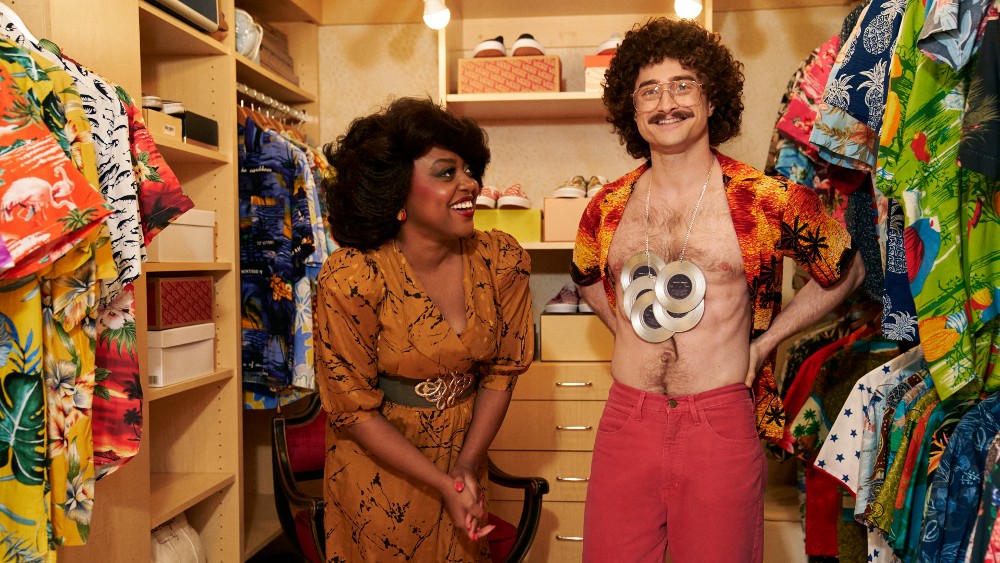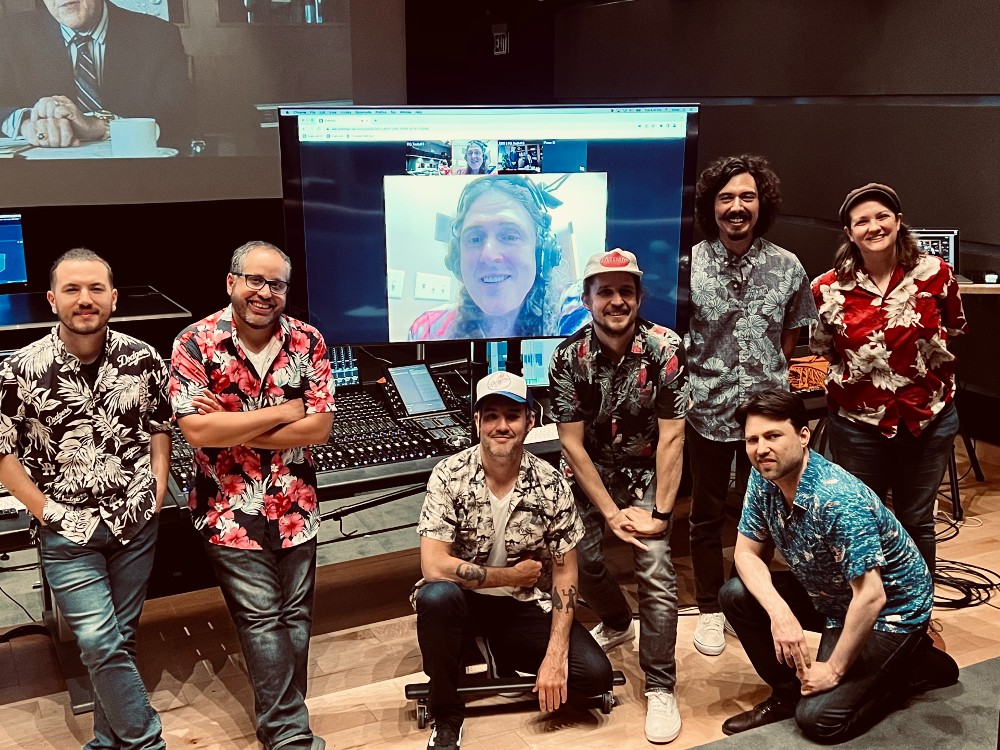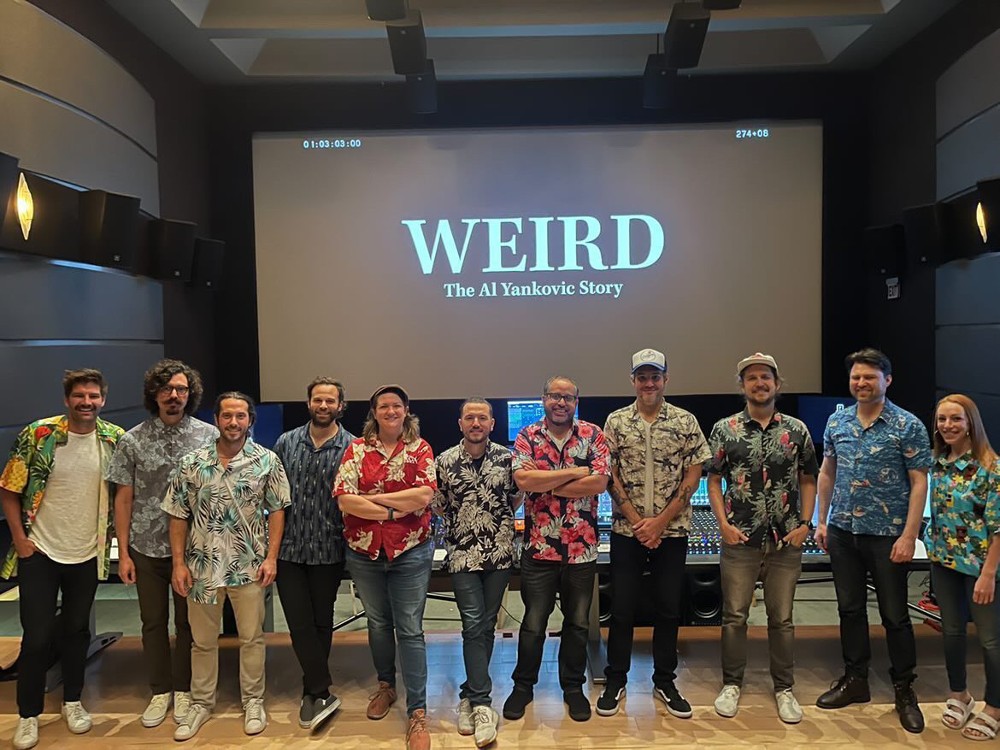
Last year’s biopic parody, Weird: The Al Yankovic Story, was a real treat for fans of Weird Al Yankovic, a musician and songwriter best known for his song parodies, but not a lot more is known about his life or early career beyond that.
Directed by Eric Appel, the movie follows Al (as played by Daniel Radcliffe) from his young days living with tough parents who did not want him getting into music, let alone playing the accordion, and then it gets into recording his first hit “My Bologna” and eventually meeting Madonna (played by Evan Rachel Wood), who drags him into a relationship fuled by liquor and drugs.
Like with some of the artist’s best-known songs, it’s a parody of the very concept of a biopic, where artistic license and liberties are taken in whatever way is necessary to get laughs out of its audience.
The responsibility for mixing together all the different elements from production, as well as sound effects and Foley, fell on Re-Recording Mixer Tony Solis, whose resumé goes back roughly twelve years, and includes everything from television to movies of all shapes and sizes. Solis received a Primetime Emmy nomination, shared with Phil McGowan, Brian Magrum, and Richard Bullock Jr., and that was just one of the seven Emmy nominations that Weird received.
Below the Line spoke with Solis a few weeks back for the following interview where we get into quite a bit of detail about what was involved with working with Weird Al to put together the mix for Weird, and how that mix ended up being suitably… weird.

Below the Line: I have a bit of an engineering background myself, not doing sound for picture, but recording and mixing music, but I love that set-up behind you.
Tony Solis: It’s at one of the mix stages at Southlake Audio. We’re working on my next feature, so I kicked everybody out of the room, so would have a space.
BTL: Weird must have been a really fun project to work on. It’s Weird Al doing his own biopic, mostly made up but with bits of truth in there.
Solis: Yeah, yeah. I learned so much about Al because of this movie. [laughs]
BTL: How early do you get involved with a project like this when there’s so much music involved?
Solis: I think they shot the movie February of 2022, February and March a little bit. The sound supervisor, Anthony Vanchure, he was a dialogue editor in a movie that I was mixing exactly in that month, and he was getting messages about interviewing to do the audio post for that movie once it was done. It was mostly because he had a relationship with Eric Appel, the director; they had known each other, and I was hearing him talk about it behind me, and I was just like, “Wait, wait, is this the Radcliffe thing that people have been talking about?” And he was like, “Oh, yeah.” That was the first project I’d done with him, and we just really gelled well together.
About a month and a half later, I had a day off. He invited me out to play golf, and while we were playing, he was like, “Do you want to mix the Weird Al movie,” and I was like, “Wait what? Really?” I thought that was Formosa, and he was like, “You can do it, because you’re freelance,” and I was like, “Sure, send me a cut.” Early on, I got a really, really, really rough cut of the movie, it barely had anything in it, no VFX or anything. I was immediately like, “Yes, absolutely,” and I started asking a bunch of questions about what Al was going to do with the music. That’s when I found out that he was going to rerecord a bunch of the songs, so that we would have separate stems on everything. A lot of the older stuff he didn’t have stems. It was like a four-track thing, so “My Bologna,” the only version that ever existed was that original recording of it in the bathroom at the bus station.
For him to rerecord it, that was the first time that he had actually done that for that song and for a lot of those other songs. I had requested, “What kind of splits are we going to have for it?” And he said, “No, it’s going to be full multitrack. You’ll have background vocals, you’ll have my main vocals, you’ll have left hand of accordion, right hand of accordion,” because its sound comes out on both sides. That was going to be the biggest thing, because that was the first note that I got, once I got the gig, the first email I got was just like, “We want all the music performances to feel like they’re in the space, that’s your biggest note.” With that, I rewatched the rough cut, I think I got sent one more cut, and just started to internalize how I was going to treat this movie, because it was all over the place. You have a comedy, you have action, you have a big score, and you have all these musical performances. How do you make it not feel like a music video in certain parts, because it’s a re-recorded track?

It was just a lot of mental planning ahead of time of just how I was going to approach dealing with those stems once I was on the stage. I knew that I was going to have a super limited amount of time on the stage, we had TIFF coming up, and the movie had to be done. They only had X amount of days allotted for the mix, so it was just setting up a game plan from the very beginning. That was maybe two and a half months before I actually sat down to mix. I was already building a mental roadmap, took some notes for myself, of just which parts of the movie I wanted to really focus on.
It was a solo mix — it wasn’t a two-man mix — it was just me, so I had to deal with dialogue, music and all the sound effects and all the Foley. It was just getting a game plan together of which scenes I was really going to hone in on and which ones they had already given me notes for that were going to be big deals. The acid trip sequence was always going to be a moment in the movie where we were going to spend a lot of time on the stage because Eric and Al really wanted very specific ways of how we were going to deal with that scene and the effects and how everything is balanced.
BTL: You share this Emmy nomination with three others, so what were Phil, Brian and Richard doing?
Solis: Phil [McGowan] was the scoring mixer. Leo and the other composer they orchestrate everything, they write everything for the score parts of the movie, that’s not the Weird Al stuff. Phil is a music mixer basically. He’ll go into the scoring stage where they have the orchestra, he’ll make sure all the mics are good, and then, put together an accurate representation of what is being recorded, like he mixes it into the recording. I get that as a bunch of 7:1 stems, and then I mix it into the movie itself. That’s why I’m a re-recording mixer. So that’s what Phil did. T
he other two are the production mixer, [Richard Bullock Jr.] is the guy on set; he’s the guy that gets the lavs, gets the booms. As a dialogue mixer myself, that’s the person I rely on the most, because that’s what I work with the most is production dialogue. And then, [Brian Magrum] is the ADR mixer. We have a lot of replaced dialogue in the movie, especially from Daniel. We had a lot of stuff, and then the hand farts were all recorded by him, and then I match all the stuff the ADR mixer does to the production dialogue and put that together. We all have our own little worlds that we sort of live in. I just happened to be the person that then puts it all together at the end. It’s always been a super huge crew effort from the editorial side to the mixing side, I’m sort of the last step in the chain on the audio side of what people end up hearing, how everything gets balanced together.
BTL: Coming from my music background, you have recording engineers and mix engineers, so it always throws me off seeing the term “Re-recording Mixer.” It seems to encompass everything from sound designers, sound editors, and of course, the person physically mixing it, as you did.
Solis: Honestly, we wear a lot of different hats these days, as re-recording mixers. I tell people that a good re-recording mixer was probably also a really good editor at some point in their career, because they understand the workflow of all this stuff behind me. You’re very technical, and you have a lot of creative know-how on how to work with fades and editorial things.
I always knew I wanted to mix movies, but I never knew that that was called a re-recording mixer, because that phrase was always so strange to me. But it makes sense. Once I got into the gig a decade plus ago, it made sense that… everything gets recorded on set, or pulled from libraries for sound design and Foley all gets recorded, and then I get everything that together, and then it’s all put into a recorder to make the main soundtrack of the movie, so it gets re-recorded. And I’m like, “Ahhh, that’s the re-recording mixer.”

BTL: Did they actually perform anything on set that was recorded for you to use in the mix? Or were they always synced to Al’s pre-recorded tracks?
Solis: All the [actors] actually knew how to play their parts. I know that Daniel did actually teach himself, with Al’s help, to know where the hands go on the accordion. Even though he was pantomiming it, he was playing the right stuff. Al was specific with him about that, and Daniel himself wanted to be in the right areas and playing the right stuff when he was doing it.
We actually added stuff on the stage. We recorded stuff on the stage of that weird little vibraphone thing that Conan plays in the outdoor scene. Eric actually recorded that on the stage. We set up a mic in front of the screen, and he recorded it. I know that Daniel was actually singing, though. We didn’t use that because we were using Al’s voice, but Daniel, that’s why you see his veins popping like in his neck. He was actually singing on set. Eric had made the comment earlier that those do exist. There are clips out there somewhere of him actually singing, and they are great.
BTL: Do you usually Vocalign or some other software to make sure that the audio from set lines up better with the vocals from the pre-record?
Solis: We would use Auto Align Post, that’s a great program. For the most part, for Daniel, he was really good at syncing to Al’s part. It was my job to make it sound like it’s coming out of his mouth, but he made my job easier because his sync was just so good. If he was mouthing weirdly, it would be hard to sell it, but props to Daniel, because he knows how to sync so well.
BTL: He’s probably used to doing ADR from a very young age as well, so he’s had to do that.
Solis: He grew up in the film world, and he actually is insanely good at ADR. The very little ADR of his that we had in the movie, it took almost no effort. It was maybe two takes of each thing, and that’s it. A lot of the fight scene stuff were efforts from him, and then him saying, “Diiiiiee!” That was just something he ad-libbed, and we loved it so much, we had to keep it, because it’s hilarious.

BTL: How did you work with Al before getting to the mix? Were you just getting stems you could lay in?
Solis: We shared an email that there was going to be a brand-new song that he wrote at the end of the movie, and that was going to be raw tracks that I was going to be sent, and to do whatever I wanted to do with them, because the song hadn’t really been mixed yet. That’s “Now You Know,” which is the song in the credits. That was a lot of fun to work with. I know that Anthony, the sound supervisor, was the one that was mostly interfacing with him and Eric, before I got on the stage.
I tend to be the person on the stage is the most “client-facing,” I guess we would say. The direct feedback that I would get from Eric and Al is what leads to how the session rolls. Al was onboard with us from the very, very, very beginning. He was super-vocal with Anthony with Mike, the sound designer, and once I was on the stage mixing, he was on tour, but he was logged in through Evercast every single day, every single minute. He would be in his greenroom or backstage and he’d be like, “Hey, guys, I’m gonna go soundcheck for like 15 minutes. So just keep working.” And then he’ll get back on and he’s like, “Hey, I’m gonna go play the show, I’ll be back in an hour and a half.” Literally, he would be offstage with a towel around his neck, logged back in and be like, “Alright, where are we at?”
He was just very collaborative. We relied on him for a lot of the scenes to let us know how stuff was landing musically, especially all the performances. That’s his music, and we wanted to represent it the way that he felt the most comfortable. He wanted us to experiment, both him and Eric were very much like, “Let’s throw a bunch of spaghetti at the wall and see what sticks because it’s a weird movie.” We already knew that we had to be as weird as humanly possible. It couldn’t be a general mix for me. My notes from the beginning at that point was throw everything you know away. It’s a weird mix, so we can get away with a lot.
BTL: He’s produced all his music over the years, too, so he’s been very hands on with all the music he’s recorded over the decades.
Solis: It was great, because with that musical knowledge, he has a pretty good technical sound knowledge. He was able to communicate with me in language that I understand very well, and I could communicate back to him in language that he understands. It’s not like with certain clients where it’s like, “I want it to sound more purple” or something like that. He’ll be like, “Let’s cut the low mids there, let’s boost a little bit above 5k here.” His notes were always that technical usually. They’d be very specific about, “Let’s compress this just a little bit more. Let’s take off compression on that just a bit more to let it breathe.” It was really cool to have someone that was so involved in a movie that’s about him that is also technically a sound person himself, because he’s such an accomplished musician.
BTL: Did you say that you were on the stage mixing for just five or six days?
Solis: Six days. The movie is six-ish reels — it’s like five and a half, six reels. Technically, it was seven days, but it was six working days because the seventh day is a print master day. That’s why I needed to have a game plan from the very beginning of knowing that if I have a reel a day, this is what I need to do on this reel. I got the reels sent to me beforehand, so that I can drop markers and pre-mix a little bit, just sort of setting it up in my templates, and making sure that we don’t use stage time for technical things. We’re just there to mix and do all the creative stuff.
BTL: Was there any section of Weird that was particularly difficult that you knew you’d have to spend more time on than the rest?
Solis: For me, honestly, it was the acid trip sequence. I already knew from watching the rough cuts that there was going to be a lot going on, but then once I had all the elements on the stage, I didn’t know that the score was going to be so huge. So now I have dialogue that needs to be heard, a lot of sound design, and then this really rich score, that I have 24 7:1 stems all playing at the same time. That was Reel 3, I think it was, and we got to that point towards the end of Day 2, beginning of Day 3. I think all of Day 3 was just that scene, because there was so much happening in it. What you hear in the movie is an incredibly massaged version of 300 tracks, all playing at the same time.
I knew that I wanted to get to that point in the movie, because I knew that that was going to be a really slow process, knowing that it was going to be so busy. That and then the “Like a Surgeon” concert sequence, because I knew I was gonna have crowd [noises], and I was gonna have a lot of call and response [with] the audience and creating the proper space. That I knew was going to take a bit of time, so those are the two sections of the movie that I already knew. “Alright. I need to get my bearings on the stage.” Everything else, I had a plan for, but those were just like, “That’s going to be a difficult section.” I wouldn’t even say that difficult, just challenging knowing, “How do I approach this? How do I paint this picture?” You do this for enough movies, and you still don’t get used to that. That’s why I love doing what I do, because every film is a completely different challenge. That’s sort of what glazes my donut. I love those challenges, and that’s the art in it for me. This next movie is the same thing. It’s a completely different planet for me, and it’s just fun [chuckles].

BTL: I was curious about how you go about building a mix, because I know how to do that for music mixing, but where do you start on something for picture, do you always start with the dialogue? Or do you mix the dialogue and the score separately, and then try to get those two things together before adding other elements?
Solis: Great, great, great, great, great question. A lot of guys that do what I do, we all say “Dialogue is king.” In a movie, that’s what pushes the story forward most of the time. I do a lot of dialogue-driven stuff in my career, but if I’m by myself – if it’s a one-man mix versus a two – I always build out my dialogue, I get it sitting in a space in a calibrated room that is very comfortable, that I can understand, it’s all intelligible. From there, I usually do that with the backgrounds active, so I know how the atmosphere feels. I tend to actually then build the score the music around that, and then I bring in all the Foley and sound effects to just fill out the rest of the world. It’s just like the garnishes on top.
When it’s a two-man mix, it’s a little different. Like this new movie, I’m only doing dialogue and music, but the sound effects mixer is sending me his backgrounds, because I want to know how the world sounds, so I know where to put the dialogue in that world. I’m dealing with reverbs, and I’m dealing with compression. I have five different reverbs that I go through on any given mix, and I stack them on top of each other. I do a lot of weird room building.
That’s how I tend to piece it all together. I always start with dialogue, build out the music around it, and then fill it in with the world, be it all the sound effects and Foley. And then, you just listen to it and balance it out from there. Dialogue needs a little push here. I don’t want anybody to ever question what that line of dialogue was, so that’s why I always start with dialogue no matter what, just make sure that by itself, can I understand what it’s saying? Then no one’s gonna need subtitles. [laughs] That’s how I look at it. My fiancée, she watches movies with subtitles, and I hate it. I’m like, “Why?” “Because I don’t know what they’re saying.” There is a world right now that we live in where a lot of dialogue isn’t that intelligible, so you need that subtitle, but as a dialogue mixer, I don’t want you to reach for the subtitles. I want you to understand what the person is saying.
BTL: I spoke to the editor of Mission: Impossible recently, and he told me that Christopher McQuarrie likes to do his edits with no sound whatsoever, no temp music, because they want to make sure it works just as visuals.
Solis: That’s smart. You’re not letting your ear dictate your picture motion. I’ve talked to picture editors that will do it that way, and they tend to have a really cool flow. I know other picture editors that edit with music, because they want the music to dictate the flow of the edit. That’s a whole other art, and I appreciate what they do so much.
Weird: The Al Yanovic Story is available to stream via the Roku Channel.





